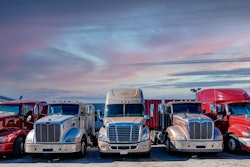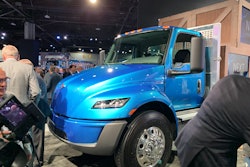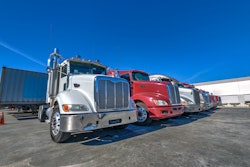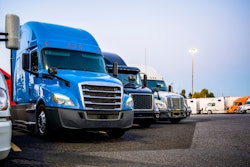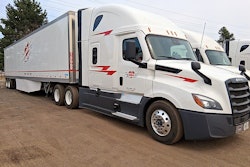I’ve always enjoyed my business travel to China. Ignoring the time zone differences where I was wide awake at 2 a.m. in my hotel room, it is a great experience. The people are nice, the food is great, and the work ethic is high. I’ve always learned a lot on these trips and developed a great deal of respect for the innovation in products and manufacturing by Chinese businesses.
In 2015, I traveled to China and took my first ride in a battery electric vehicle (BEV). A colleague picked me up from the hotel and we drove to the one of our plants. He explained to me how BEVs were becoming very common, how China had invested in this technology, and how the government provided incentives to purchase a battery electric passenger car. He said the government would soon be directing its attention to heavy-duty battery electric trucks. This was back in 2015.
Today, electric vehicles are growing and already account for a respectable percentage of the market in China. A recent study by ICCT showed BEV adoption over the last few years for transit buses, midrange trucks, and heavy-duty trucks. Transit bus adoption is 89% of new vehicle sales. Heavy-duty adoption is 13% as illustrated in Figure 1, and it’s on the rise. Note also that natural gas adoption is 29%.
 Figure 1: Market share of heavy-duty trucks in China. ICCT
Figure 1: Market share of heavy-duty trucks in China. ICCT
The feeling within China is that BEV adoption of BEVs by the heavy-duty market will continue. One view is that the heavy-duty trucking sector might see a “one-third, one-third, one-third” split between diesel, battery electric and natural gas vehicles. In my opinion, this is very practical and makes a lot of sense. I think it could be a good long-term solution for the U.S. until there is some major breakthrough in batteries. Said another way, as long as we are in the Messy Middle.
This leads me to ask two questions: If BEVs work in China, why can’t they work in the U.S.? And, should the U.S. become a fast follower or smart follower?
I learned in my career that you don’t always need to be the technology leader. There are pros and cons to leading versus being a fast follower. A fast follower, or even a “smart and steady follower,” might be the right approach for the U.S. The word “steady” is a key in today’s political climate. Hopefully, we can continue to invest in and develop alternative fueled vehicles.
I studied the China situation a bit and learned some things. While Chinese trucks are different from U.S. trucks, some of these differences are worth noting.
Costs
In the U.S., the price of a BEV is 2 to 2.5 times higher than that of a diesel vehicle. The battery is approximately 70% to 80% of the cost of the powertrain and a major cost driver. There is a huge difference between the cost of batteries in China and in the U.S. Figure 2 shows the trend of battery prices in China for passenger cars. Note in 2024, they were $56/kWh. In the U.S., the estimate is approximately $115/kWh. This difference is significant. There are different estimates, but in general, you can expect at least a 30% to 50% lower price in China than in the U.S. Other components such as electric motors, power inverters, etc., also cost less in China. Some people I’ve talked to indicate that prices in China can be only one-third of those in the U.S. While these numbers are for passenger cars, it’s safe to assume there is a similar premium for Class 8 vehicles. China has dominated this area; it has a good handle on the whole supply chain. It has over-capacitized its battery manufacturing, which has resulted in battery price wars.
 Battery price trend for Chinese electric passenger cars. Volta Foundation
Battery price trend for Chinese electric passenger cars. Volta Foundation
There also appears to be a large disparity in the price of electricity. First, it should be noted that the price of electricity varies significantly. There is no single price. The price of electricity depends on the region of the country, time of day usage, power usage, whether the charging infrastructure is private or public, etc.
Many reports that project BEV adoption in the U.S. have talked about BEVs reaching total cost of ownership (TCO) parity with diesel. Many of these projections assume an electricity price of around $0.11/kWh. In my experience, pricing can vary significantly by region and even time of day. Using national averages can be deceptive when calculating TCO.
In China, I hear that price of electricity can be as low as 0.07 cents to 0.11 cents per kWh, but can be as high as 0.2 to 0.25 $/kWh range. In the U.S., if a fleet has its own charging capability, it might be able to pay as little as 0.15 $/kWh. However, this is the very best price, and the range is more likely to be 0.2 to 0.3 $/kWh. These are average pricess assuming peak hours are avoided. Prices can be well north of 0.5 $/kWh at certain times of the day and in different regions of the country. In the case of private charging, the fleet needs to pay for the chargers and utility upgrades, which can be in the millions of dollars range. As for public charging, the lowest costs are at 0.45 $/kWh and likely can be higher than 0.6$/kWh.
Pulling all of this together, Ryder issued a report in 2024 and estimated the total cost of transportation to be 22% to 28% higher for medium-duty BEVs versus diesels, and 94% to 114% higher for heavy-duty BEVs versus diesels.
While I have not read a similar report for Chinese trucks, if you do some quick math and consider at least 30% to 50% lower upfront costs (e.g. battery, motor, etc.) and lower electricity prices in China, you can quickly see how some Chinese fleets could very well see positive TCO for BEVs.
Incentives and government subsidies
Perhaps incentives and government subsidies can explain the cost difference. We know that China has been investing in BEVs for a long time, but it is hard to understand exactly how much has been spent on this technology. One data source indicated that CATL, the largest battery manufacturer in China, received approximately $1.8 billion between 2018 and 2023. That’s a lot of money; however, the U.S. also has invested billions of dollars in battery companies. One source indicates that as of July 2024, the U.S. awarded grants totaling more than $22 billion through the Inflation Reduction Act and the Infrastructure and Jobs Act. Figure 3 represents cumulative investments, which are not only from the government but also companies and investors. Both countries have invested heavily, but China clearly invested early, and those investments probably explain China’s dominance in cost leadership. Figure 3 indicates “committed” battery investments, and since China started investing so much earlier, its “commitments” have turned into real plants where the U.S. is just breaking ground in many cases. Cost leadership comes from production optimization, supply chain optimization, and value engineering. This takes time, and China has been at it much longer. Also, given changes in the administration in the U.S., it is unclear whether these commitments will turn into real production.
 Committed battery invests in the U.S. and China. EV Hub
Committed battery invests in the U.S. and China. EV Hub
Before leaving the topic of investments, it is also worth discussing the speed at which new products are being developed. China can develop a new product in half the time it takes in the U.S. It has a different philosophy, probably along the lines of minimum viable product (MVP). This process focuses on getting something into the customer’s hands as quickly as possible and allowing rapid development and feedback of the concept. The product will not be tested as thoroughly as is done in more traditional product development processes, and the customer understands this. Speed is helpful in that it gets the feedback early in the process, but it also reduces the engineering spend.
Grid issues
China is making huge investments in its grid. It is spending billions of dollars to upgrade the grid and has created major BEV corridors. It has deployed 13 million chargers, compared to 230,000 in the U.S. That statistic summarizes quite well how advanced China is and explains why it is leading in the BEV space.
As for “greenness,” the two countries have similar statistics. Fossil fuels make up approximately 60% of the grid for both countries with renewables and nuclear making up the remainder.
When thinking about emissions regulation, it is important to separate criteria pollutants from greenhouse gas emissions, as explained in an previous blog of mine. China has been regulating NOx and PM over the last several decades. Those emissions reductions are not as severe as what we will see in 2027 with the EPA Low NOx rule, but they are stringent enough to require aftertreatment. China does not have any regulation in place today to reduce CO2. It does have a “30-60” goal, which sets the expectation for reaching peak CO2 by 2030 and then being carbon neutral by 2060. It also has some fuel economy standards, and has limited diesel in cities such as Shenzhen during certain hours of the day, but none of this seems to explain the country’s leadership in BEVs.
There is no doubt in my mind that China is the leader in the BEV space. In my opinion, it is being practical by simultaneously growing its natural gas engines for applications that are not suited to BEVs.
While China is the leader, can the U.S. be a fast or smart follower? I certainly hope so. With innovation, we can drive costs down and make the BEV case more attractive. We need to continue investing in battery technology and the supply chain. There are many ways to lower the cost of BEVs in the U.S., and I will explore this in a future blog. My hope is that we can get these costs down, improve BEV adoption, and simultaneously grow alternate fuels.





